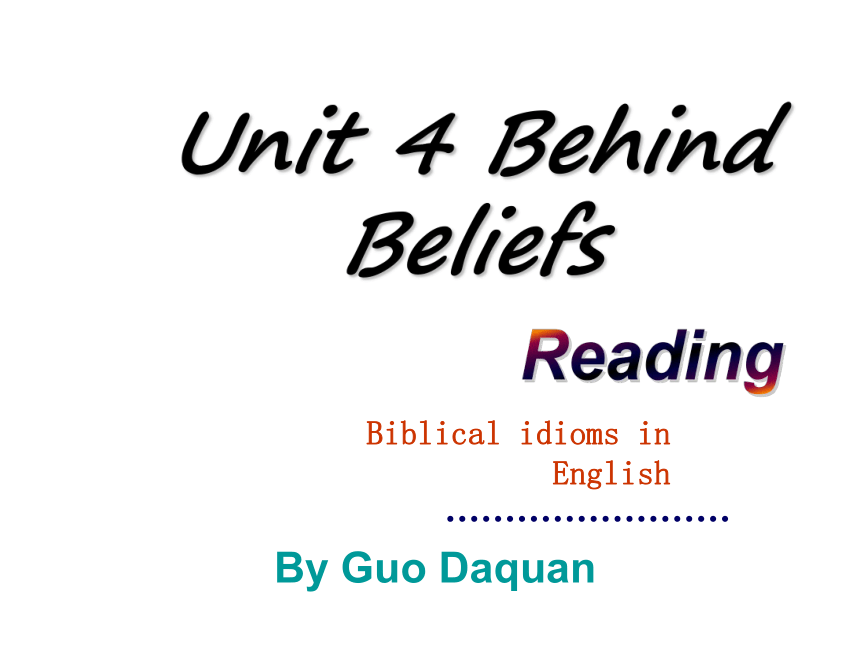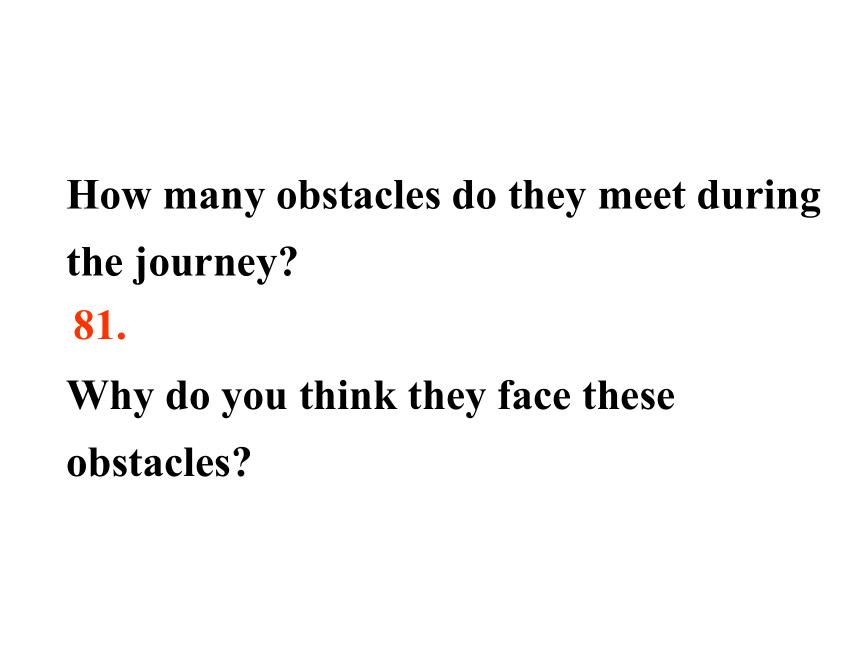英语高中牛津译林版选修九Unit4《Behind beliefs》课件1
文档属性
| 名称 | 英语高中牛津译林版选修九Unit4《Behind beliefs》课件1 |  | |
| 格式 | zip | ||
| 文件大小 | 728.4KB | ||
| 资源类型 | 教案 | ||
| 版本资源 | 牛津译林版 | ||
| 科目 | 英语 | ||
| 更新时间 | 2013-03-16 10:52:25 | ||
图片预览












文档简介
课件31张PPT。
Unit 4 Behind BeliefsReadingBiblical idioms in EnglishBy Guo Daquan Are you familiar with the ancient
Chinese story Journey to the
West? What do you know about it?a classic piece of Chinese literaturemain characters include a Buddhist monk who is also known as the Priest of Tang and his three followers, Monkey King, Pigsy and Friar Sand.a trip to India for BuddhismHow many obstacles do they meet during the journey?81.Why do you think they face these obstacles?to give the monk and his three followers an insight into their own characters and show that people must often struggle to succeed
to symbolize the difficulties and challenges that people meet in the course of doing what they believe inWhat religion is it related to?Buddhism7 Buddhist site The Mogao Grottoes
In Dunhuang, Gansu Province 8 Buddhist site The White Horse Temple
In Louyang, Henan Province 9 Tibetan Buddhist site The Potala Palace
In Lhasa, Tibet10Symbols and god of Buddhism11What do you know about Taoism?12What does the yinyang mean? Symbol of Taoism13 Taoist site Mount Wudang
In Hubei ProvinceTaoist monks14Christmas is a religious day Christmas , a Christian holiday, is celebrated in many different countries. Every year in December Christians celebrate the birthday of Jesus Christ. Christianity The Bible is often described as "the greatest book ever written" because of its unending significance and influence on people throughout the ages.
Many basic concepts and principles of Western culture have come down from the Bible. Many common English phrases and expressions have their origin in the Bible as well.Biblical idioms in EnglishFill in the blanks with proper words according to the Chinese given in the brackets. 1. While listening to the terrible story, I felt my facial __________(表情) beginning to change.
2. All the mistakes in my English composition had been ___________(加下划线) in red ink by my teacher.
3. Don’t worry. There are two___________
(直截了当的) ways of achieving this result.
4. The instructions for this clever method are given __________(频繁地) and are easy to understand. expressionunderlinedstraightforward frequently 5. He was rather ________(含糊的) about the reasons why he was so late for class this morning.
6. Being inspectors should have a _________(完全的) knowledge of construction materials, otherwise, quality problems will come up in some buildings.vague thorough Fast reading Go through the passage as
quickly as possible and try
to find the answers to the three
questions in part A on Page 50. 1. What is an idiom?An idiom is a group of words or an
expression whose meaning is not
straightforward ,because it often can
not be understood by looking at the
meanings of the separate words.2. Which languages was the Bible first
written in?In Hebrew and Greek. 3. Which idiom is often used to describe
children? ‘the apple of somebody’s eye’. Discuss with your partners and try to
divide the text into 4 parts with the
help of main ideas of each part given
to you. What is an idiom? (Para ______)
Why does the Bible have a lot of idiom?
(Para ______)
3. What are the features of Biblical idioms?
(Para ______)
4. Why should we learn idioms well?
(Para ______)
1 2 3-67 Structure analysisCareful reading 1. Read Para. 1 and 2 again carefully. Answer the following T/F questions.
The meanings of an idiom is always the
same as the meanings of its components.
b. You can easily misunderstand a
sentence if you don’t recognize an
idiom is being used.
c. The original meaning of Biblical idioms
have never changed.2. Read Para 3-6 carefully and answer the following questions:
1)Why does the Bible have a lot of idioms?
2)What does “feet of clay” mean?
3) What animal is used in an idiom in the article?
4) Which idiom in the text is related to agricultural life?
(1)Why does the Bible have a lot of idioms?
Because the Bible was first written in Hebrew and Greek, and many idioms are used in both of them.There is a hidden weakness in somebody
whom we admire or respect.(3) ) What animal is used in an idiom
in the article? Calf.(4) Which idiom in the text is related to agricultural life? ‘You reap what you sow.’(2) What does ‘feet of clay’ mean?
3. Read paragraph 7 again carefully and try to list the benefits of learning idioms. improving your _______________
Developing a high level of competence in your _____________ _______
Better _____________ and ____________ the _________ and _____________ of English-speaking countries
comprehension communication skillsunderstanding appreciating history cultures
How many idioms have been mentioned in this article? What are they?6 idioms.
by and by,
feet of clay,
see the handwriting on the wall,
kill the fatted calf,
you reap what you sow,
the apple of somebody’s eye.
Can you use them properly?Practice : Choose the correct idiom from the text to complete each sentence below.
Debbie’s father always warned her to be nice to people she did not know, because we __________________
2. Sarah’s mother adores her; Sarah is _______________.
3. Wilson was disappointed when he learnt that the coach had __________.
4. She knew it might take a long time for her teammates to change their minds, but she believed that the new plan would work _________.
5. When my brother came back home from his trip to Europe, we __________________.
6. After his company suffered millions of dollars in losses, Joe ______________________________ and left the company.the apple of her mother’s eyefeet of clayby and byreap what we sowkilled the fatted calfsaw the handwriting on the wallRevision & Consolidation
Fill in the following form with proper words according to your comprehension of the text.whole/completebenefitImprovingExamplesappreciatingMeaningsresultAnimal-relatedoriginTypesThank you!
Chinese story Journey to the
West? What do you know about it?a classic piece of Chinese literaturemain characters include a Buddhist monk who is also known as the Priest of Tang and his three followers, Monkey King, Pigsy and Friar Sand.a trip to India for BuddhismHow many obstacles do they meet during the journey?81.Why do you think they face these obstacles?to give the monk and his three followers an insight into their own characters and show that people must often struggle to succeed
to symbolize the difficulties and challenges that people meet in the course of doing what they believe inWhat religion is it related to?Buddhism7 Buddhist site The Mogao Grottoes
In Dunhuang, Gansu Province 8 Buddhist site The White Horse Temple
In Louyang, Henan Province 9 Tibetan Buddhist site The Potala Palace
In Lhasa, Tibet10Symbols and god of Buddhism11What do you know about Taoism?12What does the yinyang mean? Symbol of Taoism13 Taoist site Mount Wudang
In Hubei ProvinceTaoist monks14Christmas is a religious day Christmas , a Christian holiday, is celebrated in many different countries. Every year in December Christians celebrate the birthday of Jesus Christ. Christianity The Bible is often described as "the greatest book ever written" because of its unending significance and influence on people throughout the ages.
Many basic concepts and principles of Western culture have come down from the Bible. Many common English phrases and expressions have their origin in the Bible as well.Biblical idioms in EnglishFill in the blanks with proper words according to the Chinese given in the brackets. 1. While listening to the terrible story, I felt my facial __________(表情) beginning to change.
2. All the mistakes in my English composition had been ___________(加下划线) in red ink by my teacher.
3. Don’t worry. There are two___________
(直截了当的) ways of achieving this result.
4. The instructions for this clever method are given __________(频繁地) and are easy to understand. expressionunderlinedstraightforward frequently 5. He was rather ________(含糊的) about the reasons why he was so late for class this morning.
6. Being inspectors should have a _________(完全的) knowledge of construction materials, otherwise, quality problems will come up in some buildings.vague thorough Fast reading Go through the passage as
quickly as possible and try
to find the answers to the three
questions in part A on Page 50. 1. What is an idiom?An idiom is a group of words or an
expression whose meaning is not
straightforward ,because it often can
not be understood by looking at the
meanings of the separate words.2. Which languages was the Bible first
written in?In Hebrew and Greek. 3. Which idiom is often used to describe
children? ‘the apple of somebody’s eye’. Discuss with your partners and try to
divide the text into 4 parts with the
help of main ideas of each part given
to you. What is an idiom? (Para ______)
Why does the Bible have a lot of idiom?
(Para ______)
3. What are the features of Biblical idioms?
(Para ______)
4. Why should we learn idioms well?
(Para ______)
1 2 3-67 Structure analysisCareful reading 1. Read Para. 1 and 2 again carefully. Answer the following T/F questions.
The meanings of an idiom is always the
same as the meanings of its components.
b. You can easily misunderstand a
sentence if you don’t recognize an
idiom is being used.
c. The original meaning of Biblical idioms
have never changed.2. Read Para 3-6 carefully and answer the following questions:
1)Why does the Bible have a lot of idioms?
2)What does “feet of clay” mean?
3) What animal is used in an idiom in the article?
4) Which idiom in the text is related to agricultural life?
(1)Why does the Bible have a lot of idioms?
Because the Bible was first written in Hebrew and Greek, and many idioms are used in both of them.There is a hidden weakness in somebody
whom we admire or respect.(3) ) What animal is used in an idiom
in the article? Calf.(4) Which idiom in the text is related to agricultural life? ‘You reap what you sow.’(2) What does ‘feet of clay’ mean?
3. Read paragraph 7 again carefully and try to list the benefits of learning idioms. improving your _______________
Developing a high level of competence in your _____________ _______
Better _____________ and ____________ the _________ and _____________ of English-speaking countries
comprehension communication skillsunderstanding appreciating history cultures
How many idioms have been mentioned in this article? What are they?6 idioms.
by and by,
feet of clay,
see the handwriting on the wall,
kill the fatted calf,
you reap what you sow,
the apple of somebody’s eye.
Can you use them properly?Practice : Choose the correct idiom from the text to complete each sentence below.
Debbie’s father always warned her to be nice to people she did not know, because we __________________
2. Sarah’s mother adores her; Sarah is _______________.
3. Wilson was disappointed when he learnt that the coach had __________.
4. She knew it might take a long time for her teammates to change their minds, but she believed that the new plan would work _________.
5. When my brother came back home from his trip to Europe, we __________________.
6. After his company suffered millions of dollars in losses, Joe ______________________________ and left the company.the apple of her mother’s eyefeet of clayby and byreap what we sowkilled the fatted calfsaw the handwriting on the wallRevision & Consolidation
Fill in the following form with proper words according to your comprehension of the text.whole/completebenefitImprovingExamplesappreciatingMeaningsresultAnimal-relatedoriginTypesThank you!
同课章节目录
- 模块9
- Unit 1 Other countries, other cultures
- Unit 2 Witnessing time
- Unit 3 The meaning of colou
- Unit 4 Behind beliefs
- 模块10
- unit 1 building the future
- unit 2 people on the move
- unit 3 protecting ourselves
- unit 4 law and orde
- 模块11
- unit 1 careers and skills
- unit 2 getting a job
- unit 3 the secret of success
- unit 4 the next step
